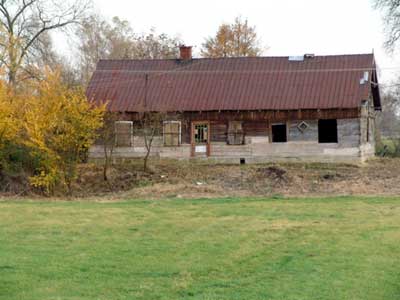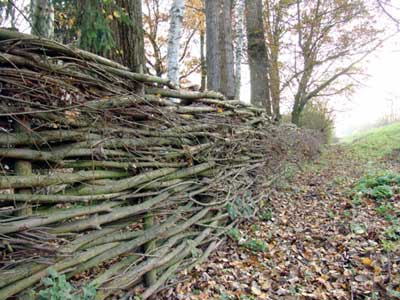 |
 |

|
Why Niemiecki?by Marcin Zamorski |
|
Marcin Zamorski is a writer of tourist guides for bikers (www.wyspawolin.pl). He lives with his family in Warsaw and takes a vivid interest in the history and the stories behind the areas he writes about. Exploring the area North West of Warsaw and collecting materials for his new book, some unusual details of the landscape caught his attention and he started to ask questions … |
Get document Why Niemiecki - Size 140 KB |
|
I was born, grew up, and spent all of the 34 years of my life in Warsaw, actually not far from the Wisła (Vistula). During all that time I've never heard about German-speaking farmers living nearby for almost two hundred years. To be exact - almost never. I can remember only one time, when my grandma, telling me stories from those great years before 2nd World War, mentioned a name of the a village near Warsaw - Kazuń Niemiecki. Regardless of the actual story, I asked: "Grandma, but why Niemiecki? (which means "German" in Polish). This name sounded to me a little bit scary and at the same time interesting (as anything that was "German" at this time). Grandma told me that the village was mainly inhabited by Germans, but she did not know more about them. That was the first and the last time I've heard about the German colonists - even after the fall of communism, when newspapers, magazines, TV and radio were full of the forgotten episodes of the polish history. Last time - until now. For the last three years, I've been traveling frequently by bike to the North-West peripheries of Warsaw. My tours regularly followed the left bank of the Vistula. From the first moment I was surprised how much the landscape changes within 2-3 km from the riverbank. It's so much different from the normal look of the villages in the Mazovia region. It's very peaceful, mellow, idyllic and extremely relaxing. The flat, regular fields with small lakes and plashes. And those beautiful trees: shortly cut, "hairy" willows, standing in straight rows. I loved to go there especially on the sunny weekends in May - taking my wife and my little boy with me. We stretched out on the green grass, collected flowers and stared at the clouds in the sky. Looking at the wild, beautiful river we couldn't believe that it still is one of Europe's most polluted. Even without having noticed the characteristic old wooden houses at that time, I was sure that there must be some kind of story behind the unusual form of the landscape and plants of that area ... The question, what this story could be, stayed on my mind. Last year I started to collect materials for a biker-tourist guide covering among other issues the Vistula banks West of Warsaw. That was the moment when I also started to look seriously for an answer to this question. I found an answer rather quickly on the Internet and in some other tourist guides: the Dutch colonists. As it turned out, the history of the colonization of the Vistula banks by so called "Olenders" (which is the old polish meaning of "Dutchmen") had become quite popular among the Polish local historians and ethnologists. There were several polish scientific studies and articles and at least two books, published lately covering this issue. I think the most interesting of them was "Katalog zabytków osadnictwa holenderskiego na Mazowszu" (Catalogue of the monuments of the Dutch settlement in the Mazovia region), written by Jerzy Szałygin, an architecture historian from Warsaw. It's a very detailed study of the former "Olender" villages along the Vistula banks between Płock and Warsaw, listing every remaining building and cemetery. After reading this book carefully I decided to visit again my favorite places to look for some of the monuments. I also wondered if anybody there still remembered those unusual neighbors. My first impressions were sad - in most cases willows and the subtle landscape were the only reminders of the colonists. Even the place names "Niemiecki" had been changed to "Nowy" (new) after the war. The few original wooden houses that remained up to this day, usually were in a poor condition.
Old farmhouse near Secymin - Photo by Marcin Zamorski, 2004 I also visited three old cemeteries. Two of them, in the deserted villages Famulki Krolewskie and Wladyslawow - deeper in the forests of the Kampinoska National Park - practically didn't existed anymore. The tombstones had been stolen (people told me they've been used to build the foundations for the new houses) and the brushwood grew highly and all over the place. Only in the cemetery of Secymin Nowy the situation was different. Why - I'll describe that in detail in the last part of this text. Generally speaking, all those places looked like the colonist's history had been almost totally forgotten by the people living here now. I was wondering if this was really the case. So I started to ask questions. Unfortunately, in most cases the elderly people I've talked to, didn't know anything. They settled here after the war, being the polish refugees from the East. Younger people only recalled from what their parents said, that "a lot of Germans lived around here". Finally I succeeded in finding an eighty-something years old man who remembered everything very good. This is what the old man told me: "We were one of only two Polish families living here in Myszory and Famułki Królewskie. All the others were Germans. Before the War, we had a very good relationship. Since our place was further away from the river than the other villages, we did not have to fear the Vistula floods. After one of the bigger floods some German farmers who had lost their stocks to the water, came to my father to buy wheat. I remember that all of them, in spite of seeing us for the first time, named him "neighbor" [which usually is used in Poland only among people living the same array of farms]. We went to school with the German and the Jewish boys - and we were good friends. The only difference between us was that one day per week we went to different churches. They spoke good Polish, but they had that characteristic accent. The Germans were very good farmers, very devoted and hard-working and in most cases more wealthy than we were. Everything changed during the war. For most of our neighbors the German offence was a disaster. They felt very uncomfortable with the situation they were in and didn't want to change our good relationship. But there were of course bad attitudes on both sides - especially within the younger generation. In the first days of the war, Polish boys (because most of the adult men were in the army) took rifles and tried to arrest some of the farmers and take them as German spies to Bereza Kartuska. I don't think that those, who were accused really were the spies, not as far as I know. A lot of the younger Germans in other villages sympathized with Hitler and were members of the confidential Nazi organizations. Of course, most of those Polish guys were later killed by the Gestapo. During the occupation, among us neighbors there were some who treated us like subordinate people and claimed that now they were in charge. But my family didn't suffer any serious harm from their side. In some other villages Nazis arrested people in the streets and transported them far away to the 'Reich' as forced laborers. But in our village the community chief, who was a friend of my father, came to us and told that there's an order to send one male from each Polish family and gave us the opportunity to decide, whom to send. My parents choose me, and I went for 3 years to East Prussia. When what the Germans called "Ivan Front" [the front of the Soviet Red Army] came close, all of the Germans ran. Some of them came back after the war, but their houses had already been taken over by the refugees from the destroyed Warsaw and from the East. I missed my friends very much." Up to now, this old man was the only one I met who remembered the German colonists. But although it seems that in most cases they did not survive in the memory of common people, some elements of their tradition survived in one way or the other. Driving through the villages near the Vistula I noticed lately some newly reconstructed willow-wattle fences. I spoke to the owners of one of them - young people who moved there a few years ago from Leoncin. It turned out that they didn't know the origin of this kind of fences and never ever heard about the colonists. But they saw similar fences in one of the farms around and liked them so much, that they decided to "copy" them. It turned out that there are still some men in the village skilled in building this kind of fences (in fact building them isn't as easy as it looks). Since today a lot of people from the cities buy old farms here around to use as summer houses, I think that there are chances, that this "fashion" will spread all over the region.
Willow-wattle fence - Photo by Marcin Zamorski, 2004 There is also one, but very positive example of taking care of the colonist heritage – the former Lutheran church in Secymin Nowy, which is one of two officially registered architectural monuments built by the colonists on the left bank of the Vistula between Wyszogród and Warsaw. Today the church is owned by the Roman-Catholic parish. Although it is used only a few times each year, it's been restored very carefully a few years ago. The same parish also takes care of the old Lutheran cemetery - they cleaned it from the weeds and built a new fence along the front side of it. I've heard that the head priest of the parish even thought about opening a museum in the old church. Actually, Secymin Nowy and Nowy Wilków are the only places in this region, where the original settlement structure remained to a larger extent. Lot of the village buildings there have been bought lately for summer houses - among them some old colonists houses, so there is a chance they will be restored. In spite of the current situation I think there are also chances, that some of the colonist's history can be brought back somehow. For us Poles, living today in one of the most ethnically homogeneous countries in Europe, the multi-cultural history of Poland becomes more and more fascinating. Best example is the history of polish Jews that has been a taboo for years and now is intensively researched - it became even "trendy" in some circles. The same can happen with the colonist's history, which has already fascinated numerous historians. Hopefully it will be popularized by the media - this is the only way for the last reminders of the colonist's heritage to be saved. |

